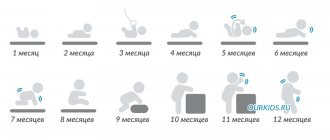Physiological changes
A seven-month-old baby's muscles are getting stronger. Thanks to this, he can take a sitting position. The child is actively crawling and trying to stand with support. His right hemisphere is actively developing, so he uses either his left or his right hand. Parents should not be afraid: at this age, the leading hemisphere is not yet defined.
By the age of seven months, the auditory and visual systems are fully formed. Their condition is easy to check: just take a rattle and shake it. The baby will turn his head towards the source of the sound. Attentive parents will notice that the child follows toys with his eyes and reacts to the faces of mom and dad. You should not teach him to sleep in silence. A little noise will be an excellent exercise for the auditory system.
This period also brings anxiety. The baby's first teeth are erupting. This is accompanied by screams and crying. But as a result, the lower incisors appear and the upper ones appear. All this is accompanied by the following symptoms:
- Temperature;
- Salivation;
- Redness and swelling of the gums.
All the skills of a child at 7 months are aimed at active knowledge of the world around him. His movements are still clumsy and awkward, he often hurts himself and hits himself. All this stimulates the development of the nervous system.
Child plays: from birth to one year
Authors : Marilyn Segal
WORLD OF A CHILD
Sitting on the floor in the middle of the room or crawling, a seven-month-old child tries to explore as much territory as possible. At some point, he finds a bunch of keys, picks it up, “talks” to it, shakes it, fiddles with the keys, hits them, waves them in the air, moves them from one hand to the other and tries to put them in his mouth. Then he grabs another toy and performs the same actions. If someone approaches the child while playing, he will be briefly distracted by raising his head, and then return to his activity. Your child recognizes more and more objects and is able to return to the interrupted activity. The baby's behavior indicates that he can concentrate attention and also solve the problems facing him. By playing with a variety of objects, comparing and evaluating their quality, the child intuitively discovers that he can simultaneously engage with several toys. His mental abilities develop as he becomes familiar with the world around him.
Motor skills
Most seven-month-old babies can sit independently. The child no longer needs to lean on his hands to maintain balance, and he performs many other actions with them - reaching, grabbing, hitting, shaking. Many children already know how to crawl. A particularly active child is able to achieve more - learn to stand on his own feet. True, going back down is already more difficult. It happens that, having gotten to his feet on his own, a child begins to scream in panic until someone comes up and helps him sit down. During this period, the baby's sleep may be disturbed. Even a soundly sleeping child will wake up, trying to crawl or stand up in his sleep. It’s as if he’s afraid to waste precious time sleeping when he has so many new important things to do. A seven-month-old child, working with different objects, also trains his hands. He usually uses both his right and left hands equally, holding the toy first in one and then repeating the same movements with the other. If a baby uses one hand more than the other, this does not mean that he is left-handed or right-handed. Motor preference may change several times before a final choice is made.
Ability to see, hear, feel
One of the most characteristic features of a seven-month-old baby is the ability to notice the smallest details of the environment. The baby immediately discovers the pattern on the new sheet and scratches it with his fingers as if he wants to take it. In addition, he begins to be interested in the interrelationship of surrounding objects. The child takes a cube in one hand, examines it, then another one in the other, and also examines it, and then hits the cubes against each other. At this age, the child explores the location of objects in space with interest. He now recognizes familiar things, such as a horn or a teddy bear, even if they are upside down, and usually returns them to their normal position. The baby’s curiosity is also aroused by the position of his own body in space. He fidgets and arches in his mother’s arms, throws his head back, trying to see the surrounding objects upside down. At this age, the child begins to understand that one object can be on top of another, even if they look like one whole. If some small thing, for example a jam socket, is placed on a larger object of a similar shape, for example on a saucer, then the baby will notice that the socket can be taken without touching the saucer. The child also seeks to explore the relationship between the front and back of an object. He will turn flat objects, such as a book or a pot lid, from side to side, trying to understand how separate surfaces with different shapes can be parts of the same object. The child's greatest interest is in round-shaped things. He will rotate the round object over and over again, trying to find its corners, find its front and back, top and bottom. The child discovers with interest that some objects have moving parts, while others change their shape. This arouses the baby's curiosity. He grabs the pieces or the string that is tied to the toy and turns it from side to side. The baby can spend at least 10 minutes crumpling a piece of foil in his hands. Realizing that objects continue to exist whether they are visible or not, a six-month-old child tried to find a rattle half hidden under the blanket. A month later, he begins to realize that there are more complex relationships between things. Having dropped the rattle from the table onto the floor, the child looks down, trying to find it there. Remember, just a few months ago he continued to stare intently at the place from which she disappeared, as if hoping that with his gaze he could bring her back. Now the baby’s actions have become more conscious and purposeful, because he knows that the rattle that fell on the floor remains there. Evidence of a child’s increased intelligence is that he is able to return to an interrupted activity. For example, the moment you enter the room, your baby is enthusiastically knocking one cube against another. He stops for a moment, looks at you, and then goes back to playing. At this age, the child already knows that hidden objects do not disappear, but continue to exist. This is especially evident during the game of hide and seek. Seven- and eight-month-olds begin to understand that an object that disappears from sight is not necessarily gone forever. When the mother hides under the scarf and then appears, the child expresses not only pleasure from the game with her joyful laughter, but also a feeling of relief. Although the baby realizes that his mother is nearby, he still wants to know for sure.
We understand our child
Every day more and more sounds appear in the child’s repertoire. Interestingly, at the same time, some vowel sounds characteristic of a two- to three-month-old baby disappeared. Now the child gives preference to consonants and can pronounce several sounds in a row at once. Often the baby will discover a particular sound and use it for a whole week before moving on to another. The baby enjoys listening to mom and dad talk and can play alone for long periods of time if they pay attention to him from time to time. At this age, the baby begins to recognize his name, and this is a significant step forward in his development. When someone calls a child's name, he stops playing and looks at the person who said it, in addition, he can communicate with others using gestures. If the child wants dad to continue playing with him, he pulls his hand or jumps up impatiently. Having noticed something interesting on the other side of the room and trying to share his discovery, the baby points his hand in the direction of the object he saw and “booms” excitedly. A seven-month-old baby loves when adults play with him. He especially enjoys taking and returning objects. He gives the toy to Dad, then reaches out to get it back. The baby finds a rattle hidden in his mother’s palm, takes it and gives it to his mother again to continue the game; his actions can be compared with how he behaved during the “dialogues” with his parents described above. A child can start a similar game with a stranger and will continue it as long as he shows interest in it. Despite the readiness to make new friends, the child continues to be distrustful of strangers. He not only expresses displeasure at the unexpected appearance of an unfamiliar guest, but also does not cease to be embarrassed, even if he remains next to him for some time. At this age, the child already distinguishes familiar and unfamiliar faces quite well and at the same time becomes more susceptible to different facial expressions and shades of voice. When an adult strictly tells a child “no,” the child stops what he is doing, at least for a few seconds.
ACTIVITIES WITH A CHILD
Practical advice
Watching other children play The child enjoys watching other children play. Let him be with kids his age and make friends among them. Listening to a tape recorder Children react differently to different tempos of music. Observe your baby: will he move, following a fast rhythm, or will he calm down and fall asleep to the sounds of a calm, quiet melody. Toys to play with Children love to play in different positions - sitting or standing. If your baby is learning to stand, remove breakable objects from the baby table and replace them with his favorite toys. Names of toys Let the child play with toys that have simple names: cup, telephone, doll, kitten, spoon, dog, cube, rattle, banana, clown.
Game time
New discoveries Show your child pictures Cut out large pictures from a magazine depicting a phone, a dog, an airplane, a spoon, a teddy bear. Glue them onto sheets of thick paper to make a book. Place your baby on your lap and “read” to him. Doll in the mirror Let your baby explore the reflections in the mirror. Show him the rag doll, and then draw his attention to its reflection. See if your child compares the real doll with its double. Toys that can respond to a child's actions Every day, your child understands more and more that he can influence the objects around him. Try to find toys for him that can respond to his actions - squeak, stretch, pop up, etc. Falling ball Your child already knows how to sit well, and he likes to play with objects that fall easily. Try dropping the ball into a large tin can. To prevent your baby from getting hurt, beat off the sharp edges of the jar. Raise your child's hand above the jar and have him drop the ball into it. The unfamiliar sound will make him curious, and he will want to do it again. Soon he won't need your help at all. Development of coordination How to maintain balance Try placing your baby on a low chair. Hang or hold an interesting toy in front of him. When he wants to reach it, he will have to balance on the chair to maintain his balance. Rock your baby up and down While listening to the song, your baby will laugh in anticipation of the upcoming “jump.” Playing with a bouncy ball Hang a large bouncy ball from the ceiling where your baby can reach it. He will enjoy hitting the ball and watching it swing. Tug of war Play tug of war with your baby. Have him grab one end of the scarf while you gently pull the other. Your child will love this fun game. Decision Making Ribbon Toy Tie a ribbon around the head of a rag doll or clown. Show your child how to pull the string so that the toys can “dance.” Small balls Give your baby a few small rubber balls. Now that his thumb is free to move, he can play with them easily. Let's knock against each other Show your child how to knock two toys against each other. Let him try to imitate your movements. Hidden toy Squeeze the toy in your palm so that the child hears a squeak. Hide it under the blanket in front of your baby and let him try to find it. In which hand? Hide a small, interesting toy in your hand. Open your palm, show it to the baby and immediately close it back. Let him look for the hidden toy. You will help your child learn that if objects are not visible, this does not mean that they disappear forever; clap your hands when he finds what is missing. Start the game over again, and if it is difficult for your baby to find the toy on his own, show it again.
Daily routine
Bath Time Floating Toys Place a few small, fun toys in the baby's bathtub. Every time your child holds one of them in his hands, tell him a story about this character. Swimming on your back Fill the bath to 5-10 centimeters, place your baby on his back and watch how he moves his arms and legs. Changing Toy If your baby doesn't like changing, keep a toy on the changing table to keep him entertained. Sing songs to your baby When bathing and changing your baby, sing him a simple song. This is how we wash our feet, Our feet, our feet, This is how we wash our feet Early in the morning. Keep singing: washing our face, changing diapers, kissing the belly, saying hello, etc. Cup in the bath If your child does not know how to drink from a cup and spills more than he drinks, give him a cup in the bath and let him play with it. He can fill it with water, pour it out, turn it over without fear of getting dirty.
Feeding time During feeding, give your baby small pieces of food, such as diced carrots, pieces of bread, or cheese. Finger paintings Pour a little yoghurt onto the children's table where the baby usually eats, and let him smear it with his fingers. Give your baby spaghetti Your child will happily tear boiled pasta or spaghetti into pieces. Without outside help Let your baby hold the horn himself, but don't insist if he refuses to take it. Some children are not yet ready for such independence.
Rest time Read a book to your child At this age, you can already start reading books to your children. Choose a book with firm pages and bright pictures for your baby. Place him on your lap so that he is comfortable. As you turn the pages, show the pictures and talk about what they show: “Look at this baby and touch him.” Try to finish the lesson before the child begins to act up. Reading should give him pleasure and joy. Turning off the lights Before turning off the lights before bed, tell your baby: “The lights are out.” After some time, the child will understand what this means.
published 05/21/2007 13:40 updated 02/16/2017 – Pedagogy and psychology
- ← Previous
- Next →
Basic indicators
If the parents have a first child, then they are very concerned about his development, they want to know what he should be able to do. They are also concerned about the weight and height of the baby. It’s not for nothing that pediatricians take measurements every month. Don't be afraid of small deviations. All tables are made based on average statistical data. Therefore, slight differences are acceptable.
Girls in the seventh month of life weigh approximately 6 kg. The maximum limit is 9 kg 800 g. The lower limit of normal height is 62 cm, the upper limit is 73 cm. For boys, the figures are slightly higher. The minimum weight mark starts from 6 kg 700 g, the maximum is 10 kg 300 g. Height is from 65 cm to 74 cm.
| Index | Bottom line | Upper limit |
| Boys' weight, kg | 7,1 | 9,5 |
| Girls' weight, kg | 6,8 | 8,9 |
| Boys' height, cm | 65,1 | 71,1 |
| Girls' height, cm | 64,1 | 70,4 |
Experts from the World Health Organization adhere to the following table:
| Index | Bottom line | Upper limit |
| Boys' weight, kg | 6,7 | 10,3 |
| Girls' weight, kg | 6,0 | 9,8 |
| Boys' height, cm | 64,8 | 73,5 |
| Girls' height, cm | 62,7 | 71,9 |
| Boys' head circumference, cm | 41,5 | 46,4 |
| Head circumference of girls, cm | 40,2 | 45,5 |
Many parents are concerned about what a baby should be able to do at 7 months. But remember: these development tables do not take into account individual characteristics. On average, during the seventh month of life, a baby should gain about 600 grams of weight and grow by 2 cm.
Happy birthday greetings to a 7 month old boy
Our site will help transform thoughts into words. Among the large number of original, touching congratulations, you will find the only one that will express all your feelings and desires to participate in the life of your family. With the help of unique, encouraging words, you will take care of the emotional background of the family and significantly increase the degree of happiness and smiles.
***
Seven months is the most beautiful date. Baby, you have become stronger, more beautiful and dearer, May your life become rich, with laughter, smiles, many good days.
May you only make mom and dad happy, And may you be strong, kind, and dearest to you. Let there be a lot of happiness in your life, May you grow healthy, beautiful and big.
***
As if on a throne, he sits on a high chair. Only spoons rattle on a large saucepan.
Our baby loves to play with kitchen utensils, to pick in the porridge with his finger With brave prowess.
Apparently, he needs to become a cook - He will be covered in sweets and cream And next to the food.
***
Before we knew it, seven months had passed. We congratulate the little one and wish him luck.
I wish you good health, be the smartest person in the world, let the angel at the head of the bed give you sleep and cheerful laughter.
Grow quickly and become stronger, Good for the joy of everyone! Let every day be bright, And let the number seven be a lucky one.
***
7 months. How much! Don't be embarrassed! A little more and you will start walking. Always smile like that to your parents. And don’t think about staying silent for long!
***
You have grown up a little, the baby is seven months old, the rompers have become small, he rides in a baby chair.
Good night to you without tears, When teeth are being cut, A bright childhood and dreams, Let everything revolve around you.
To always be healthy, Strong and nice, To hug an elephant in a dream, To be the main thing for your mother.
***
The little one has grown up a little, and you don’t recognize him at all. How many months is the baby? Is it really seven?
Today I want to wish health to the baby, new teeth, happy days, only happiness for the baby.
***
The baby is seven months old today, Our dear and dear baby, Just a little more, a little more, And you will become an adult, dear!
Let your little legs always explore our world, They will soon walk along the path, And suddenly your lips will say “mother!”
Grow and gain strength, May your health not fail you! Smile as often as possible, do not let sadness and sorrow come in!
***
You are already seven months old, beautiful creature, your eyes playfully glowing from the world of knowledge.
Let your days fly by in your parents' arms, and there will be a lot of love and sincere happiness in them!
***
Every month gives us joy Because you are next to us, And fatigue is such a small thing, Compared to a trusting look.
Every day brings us happiness, Because we see you. We won’t let any bad weather in the world take one step closer to you.
Every moment to be with you, Our baby, our dear child, May you be, as in a good song, Protected by love and God.
Mental development
Not only does the baby’s physical development continue, the child understands the meaning of many words and points his finger at objects. Communicates in babble. Observant parents will notice:
- The baby's reaction to his name;
- He begins to distinguish relatives by their faces;
- The child distinguishes between facial expressions, gestures, and emotions of mom and dad.
Even a baby is capable of showing emotions. He grabs his parents by the hair, presses himself against them or turns away. Begins to understand the intonation of the voice: good, angry, sad, etc.
The baby's babble becomes more and more meaningful and complex. The baby turns his head towards his mother’s voice and looks at the indicated objects. Tries to repeat the first syllable of the words: “ma”, “pa”, “ba”. Making separate sounds, he tries to attract attention.
Frequent problems in a 7 month old baby
- Pain and discomfort during teething.
Children react to the teething process in different ways. In some children, parents learn about the tooth only after looking into the mouth, but in many children, the appearance of each tooth is accompanied by increased salivation, redness of the gums and their swelling.
Often the child’s temperature rises and bowel movements may be disrupted. Cooled teethers, pain-relieving gels, and antipyretic drugs help cope with discomfort.
- Fear of strangers. Seven-month-old babies already clearly distinguish between familiar people and strangers, and may react negatively to a stranger. So you shouldn’t leave your baby alone with any person he doesn’t know. If you want to introduce your baby to someone, stay nearby, take the baby in your arms and hold him until the baby gets used to the situation and understands that the stranger is not dangerous.
- Problems falling asleep and staying asleep. Many toddlers, due to increased physical activity during the day, begin to sleep worse at night, and putting the baby to bed becomes problematic. Creating a ritual will help you with styling. Carry out the same actions with your child every day before going to bed, which will set the baby up for a night's rest.
- Refusal of complementary feeding. Many children, especially those who previously ate only mother's milk, refuse unfamiliar foods, not wanting to try mashed potatoes or thin porridge lovingly prepared by their mother. Forcing a child to try new foods is unacceptable. Don’t insist, give the baby the breast, and eventually offer a new dish again. If a child flatly refuses purees and cereals, consider the possibility of introducing pedagogical complementary foods.
Nutritional Features
It is important to monitor not only the baby’s skills. Its development, height and weight depend on proper nutrition. During this period, the baby is accustomed to different foods. Approximate diet for a baby:
- Porridge;
- Fruit, vegetable and meat purees;
- Cottage cheese;
- Boiled eggs.
Each new product should be added gradually and monitor the baby’s reaction. Some of them provoke allergies. Complementary feeding begins with vegetable purees. Many mothers notice that the baby distinguishes tastes and begins to be picky about food. This is a normal process. Closer to the age of 8 months, kefir is given. All porridges must be liquid and consist of one component. You cannot mix cereals.
Solid food is added in a small amount - baby cookies, large crackers, pieces of vegetables and fruits. This stimulates the chewing process and develops facial muscles, which are important for speech.
How do girls develop?
Differences in the development of children of different sexes are not always noticeable to a person without special education. However, they are present and quite well studied. At seven months, the baby learns to control his emotions.
Of course, this is not very noticeable yet, but now parents should distract the baby if she is upset or offended that she was not given something forbidden. Over time, the child will realize that he does not need to scream to get something, which means he will not throw tantrums at an older age.
Development of a girl at 7 months, features:
- Girls as young as 4 months can distinguish “us” from strangers and express dissatisfaction with the appearance of the latter. Boys master this skill much later;
- babies see perfectly with both eyes. It has been proven that in boys at an early age the left eye functions better;
- girls begin to speak several months earlier, so they can already clearly pronounce syllables;
- young princesses have excellent visual memory. Boys perceive information better by hearing;
- If a girl cries often, but nothing bothers her, it means she lacks communication. Psychologists say that babies from a very early age need a lot of attention, care, and conversations. Boys need a little less of all this.
Negative emotions destroy the baby's psyche. Relatives need to do everything to ensure that the baby, regardless of gender, is surrounded by positivity. This will help the correct formation of character, psyche, and behavioral characteristics.
Causes for concern
At this age, the child does not require classes. However, parents need to monitor its development, since it is better to begin correcting any violations at the initial stage. If children do not have the ability to bring a toy to their mouth or somehow grasp it, then this is a cause for concern.
Some hearing impairments may be congenital. At this age, they are easy to identify: the baby does not respond to sharp sounds, rattles, or knocking. All this is a reason to check with the ENT. Another alarming complex is the lack of eye tracking of an object.
It is impossible to talk about mental retardation at this age. An exception is some genetic diseases, such as Down syndrome, which are associated with intellectual disabilities. Delay in physical development indicates motor impairment. Therefore, if the child does not sit, does not roll over and has difficulties with coordination, parents need to consult with specialists: a pediatrician, a neurologist.
Speech, hearing and vision
The child’s hearing has become much sharper, he can hear even quiet sounds. It is better to warn your baby before loud sounds so that he does not get scared. If you are going to turn on any device that makes a loud sound, first imitate its operation with your voice.
Visually, the baby can follow fast moving objects. He carefully examines things that interest him.
The baby continues to hum, sometimes pronouncing two or three syllables in a row. The result is a kind of first words - mom, dad. But so far the baby does not pronounce them meaningfully. Learns to imitate different sounds made by adults: sneezing, clicking.
How to promote the development of a seven-month-old baby? Tips for parents
Keep talking to your baby
Babies develop vocabulary based on how much their parents talk to them, but they progress even further when they are given the opportunity to say something. Research shows that babbling is very beneficial for children's development. Talk to your baby, tell him what you are doing and give him the opportunity to “participate” in the conversation. It's very simple. Say something and wait until the child repeats the sounds. Ask questions that require a “yes” or “no” answer.
Teach your child cause and effect
Press the button on the musical toy and dance to the tune. Turn on a sound video of animal voices, listen with your child to how a cow moos, how a dog barks, how a cat meows. Repeat the sounds and encourage your baby to do the same.
Take time to play
Place toys on a carpeted floor with pillows and encourage your baby to crawl. Get creative: build a tower out of blocks and invite your child to knock it down. Try to accompany the games with music - the baby loves it, he babbles delightfully to the sounds.
If you don't mind the mess, spread applesauce on the children's table tray and let your child "draw" with the mixture. While bathing, offer him small containers and plastic dishes for pouring and pouring water.
Read books
Make time to read every day, even if it's just a few minutes. Reading aloud is one of the easiest ways to improve a child's language development. Moreover, it greatly strengthens the bond and feeling of closeness between you. Make reading more interesting with facial expressions, sound effects and voices of different characters. Keep books within easy reach so your child can study them whenever he wants.










